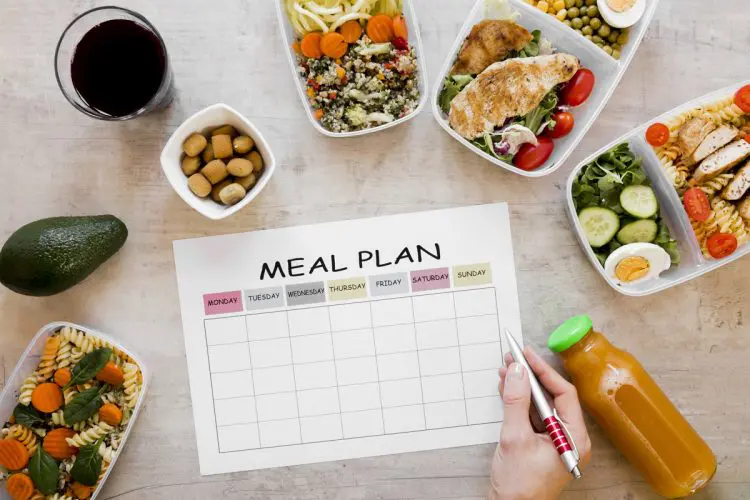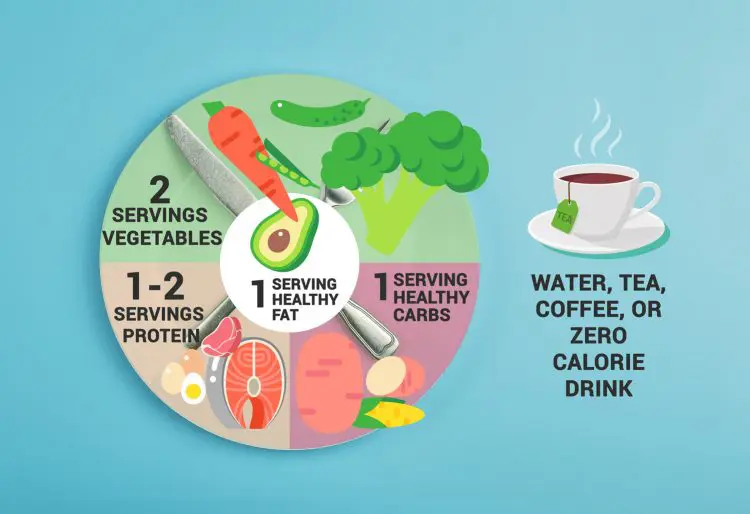Losing weight and burning fat are relatively straightforward processes. When you consume more calories than you burn, your body converts that unused energy into fat and stores it for later. This is called a calorie surplus or a positive energy balance.
To lose weight, you need to burn that fat. This involves consuming fewer calories than you need to create a calorie deficit or a negative energy balance. Faced with a calorie shortfall, your body has to use stored body fat for energy, and, as a result, you’ll lose weight (1).
Losing weight can be as easy as exercising more to increase your energy expenditure. Or, you can reduce your calorie intake by cutting out snacks, making the switch from full-fat to fat-free dairy, eating less sugar and fewer sweets, or giving up beer. In a lot of cases, exercise and calorie restriction work best.
However, a lot of people prefer to follow a diet.
Diets take the guesswork out of weight loss because they tell you what and how much to eat. They do all the thinking for you. There are lots of diets to choose from, and while each one is different, they all work the same way – they create a calorie deficit. No deficit? No weight loss.
The Metabolic Confusion diet is another weight loss plan. In this article, we reveal what this diet is and how it works, so you can decide if it’s the right eating plan for you.
Level Up Your Fitness: Join our 💪 strong community in Fitness Volt Newsletter. Get daily inspiration, expert-backed workouts, nutrition tips, the latest in strength sports, and the support you need to reach your goals. Subscribe for free!
What is Metabolic Confusion?
The Metabolic Confusion diet works on the principle of calorie cycling. That is to say, you vary your calorie intake from day to day. This, according to the diet, speeds up weight loss and prevents weight loss plateaus by “confusing your metabolism.”
On most weight-loss diets, you usually eat roughly the same number of calories each day. For example:
- Monday – 2500
- Tuesday – 2500
- Wednesday – 2500
- Thursday – 2500
- Friday – 2500
- Saturday – 2500
- Sunday – 2500
Total for the week: 17,500 calories
With Metabolic Confusion, your daily caloric intake would like more like this:
- Monday – 3500
- Tuesday – 1500
- Wednesday – 2500
- Thursday – 3500
- Friday – 1500
- Saturday – 2000
- Sunday – 3000
Total for the week: 17,500 calories
Your caloric intake is the same; you just eat more on some days and less on others.
The idea of Metabolic Confusion is that, by varying your daily calorie intake, your body never gets used to the diet you are following. Like changing your workouts from time to time, this is supposed to prevent progress plateaus.
Unfortunately, while creating a calorie deficit will undoubtedly lead to weight loss, there is no evidence to suggest that varying your calorie intake from one day to the next will either speed up weight loss or prevent progress plateaus (2). You cannot “confuse” your metabolism, so the basic premise of this diet is incorrect.
However, before you discard the Metabolic Confusion diet, it’s important to note that it can still help you lose weight because it creates that all-important calorie deficit. Also, varying your calorie intake over the course of a week may have additional benefits.
The Benefits of Metabolic Confusion
While calorie cycling isn’t going to magically increase fat burning, it still offers some valuable benefits. The advantages of the Metabolic Confusion diet include:
Flexibility
Eating the same number of calories every day can be very restrictive. For example, what if you go out to a restaurant to eat, want to celebrate a job promotion with a few drinks, or otherwise want to consume more calories than your diet allows?
With Metabolic Confusion, you are free to eat more some days and less on others. So long as your weekly total and daily averages are correct, you’ll still lose weight. This means calorie cycling may be easier to live with than an eating plan where you consume the same number of calories every day.
Good for exercisers
While you need to eat less to burn fat and lose weight, calorie restriction can wreak havoc on your energy levels and workout performance. With the Metabolic Confusion diet, you can eat more on training days to fuel your workouts and then less on rest days when you are more sedentary and don’t need the calories.
For example:
- Monday – 3000 (workout)
- Tuesday – 2000 (rest)
- Wednesday – 3000 (workout)
- Thursday – 2000 (rest)
- Friday – 3000 (workout)
- Saturday – 2000 (rest)
- Sunday – 2500 (rest)
Total for the week: 17,500 calories
Less boredom and hunger, and fewer cravings
Let’s face it, dieting sucks; it’s no one’s idea of fun. Following a diet can be boring, and calorie restriction often means giving up your favorite foods, feeling hungry, and cravings that can make you want to cheat on your diet.
With metabolic confusion, your calorie and food intake vary from day to day. This makes things a little less tedious and also means that, on your higher calorie days, you’ve got room for some foods that you probably couldn’t eat on a diet when your calorie intake is static.
Fancy a candy bar? Have it on your next high-calorie day. Want dessert? If you can’t have one today, you can probably have one tomorrow. Metabolic Confusion allows for cheat days and cheat meals, and every dieting bodybuilder will tell you how welcome these breaks can be. Knowing that you can have days off from low-calorie eating will make your diet much easier to maintain.
It’s still a diet
Metabolic Confusion still adheres to the basic principle of weight loss – it creates the calorie deficit that forces your body to burn fat for fuel. Some diets don’t observe this principle, and as such, they don’t work. Metabolic Confusion involves eating less, and so it could help you reach your weight loss goal.
Level Up Your Fitness: Join our 💪 strong community in Fitness Volt Newsletter. Get daily inspiration, expert-backed workouts, nutrition tips, the latest in strength sports, and the support you need to reach your goals. Subscribe for free!
Metabolic Confusion Drawbacks
Because Metabolic Confusion adheres to the basic tenets of weight loss, following this plan could help you lose weight. However, there are a few downsides to consider too.
The low-calorie days can leave you feeling hungry
Eating more one day means you’ll have to eat less the next. Depending on how much you eat on your high-calorie days, those low-calorie days could leave you feeling tired, weak, and very hungry. On the plus side, you can look forward to eating more the next day.
You’re going to have to count calories
The only accurate way to control your calorie intake is to weigh and measure all the food you eat. This can be time-consuming and isn’t always easy if you are eating meals prepared by someone else. Use a food tracking app to make this process easier, but you also need to resign yourself to recording and tracking your food intake.
It may not be sustainable
The Metabolic Confusion Diet requires a lot of work and attention to detail. For some people, all this extra effort can be off-putting. For any diet to work, you need to be able to stick with it for as long as it takes to reach your target weight.
If all the calorie counting and meal planning sound like too much work, your days on the Metabolic Confusion diet are already numbered. Look for a diet you can see yourself following for a long time.
Not supported by science
While the Metabolic Confusion diet can help you lose weight, it’s only because you’re eating fewer calories. Your metabolism won’t be confused, and eating more one day, and less the next won’t dramatically speed up weight loss or fat burning (3). It’s a simple matter of calories in vs. calories out.
How to Do Metabolic Confusion
The Metabolic Diet is relatively straightforward to do. Just follow these steps.
1. Calculate your Total Daily Energy Expenditure
Using an online TDEE calculator, work out how many calories you need to eat per day to maintain your current weight. TDEE calculators take your weight, height, age, gender, and activity levels into account. Make a note of this figure.
2. Create a calorie deficit
Take 300-500 calories from your TDEE. This is your calorie deficit. The larger the deficit, the faster you’ll lose weight, but too big a deficiency could cause severe hunger and be unsustainable.
It’s better to create a small deficit you can live with for weeks or months than a large deficit that forces you to quit your diet after only a few days. Make a note of this figure. Also, multiply this number by seven to give you your weekly calorie intake.
3. Work out your high and low-calorie days
Your next step is to work out how many calories you’re going to eat per day. This means using your TDEE with your 300-500 calorie deficit and then calculating your intake for high-calorie days and low-calorie days.
There are several interpretations of calorie cycling, and they all work. Options include:
- Add 500 on high-calorie days, subtract 500 on low-calorie days
- Add 25% on high-calorie days, subtract 25% on low-calorie days
- Eat 1200-1500 calories on low-calorie days, and add the difference to your high-calorie days
4. Create your weekly schedule
Plan your week and determine which days are high-calorie days and which are your low-calorie days. You can simply alternate between high and low-calorie days or match your high-calorie days to your workouts. It’s often a good idea to have at least one high-calorie day at the weekend, so you can relax and enjoy some dietary treats with family and friends.
Once you’ve got your weekly plan, add up the number of calories per day and check that your weekly total is correct. If you are over, you may need to subtract some calories from one day to get back on track. Similarly, if you are under your weekly total, you can add some calories.
Metabolic Confusion Meal Plan
Because Metabolic Confusion is all about calorie cycling, there is no official meal plan. It’s up to you what you eat from one day to the next. So long as you hit your daily calorie goals, you should lose weight. For this diet, it’s calories that count the most. Use a food tracking app to make sure you are eating the correct number of calories per day.
However, for best results, you should try and build your meals around lean protein, vegetables, healthy fats, and complex carbs. Meals like this will help keep you feeling fuller for longer and provide you with the energy you need for training.
For more on eating for fat loss, check out this article.
Wrapping Up
The Metabolic Confusion diet can help you lose weight. That’s because it creates a negative calorie balance that forces your body to burn more fat for fuel. That deficit varies from one day to the next, which might make this diet plan a little easier to stick to, but it won’t “confuse” your metabolism, as your metabolism cannot think!
That said, if the idea of eating different amounts of calories from day to day appeals to you, or you want a diet that allows for cheat meals, Metabolic Confusion could work for you. You will, however, have to get used to counting calories.
Ultimately, the best weight loss diet is the one that is easy to live with. You’ll need to stick with it for weeks or even months to reach your weight loss goal. If calorie cycling sounds like too much work, the Metabolic Confusion diet is not for you. However, if you want a flexible diet that you can adapt to match your workout schedule, Metabolic Confusion could give you the results you want.
References:
1. PubMed: Defining the Optimal Dietary Approach for Safe, Effective and Sustainable Weight Loss in Overweight and Obese Adults https://www.ncbi.nlm.nih.gov/pmc/articles/PMC6163457/
2. PubMed: Effect of Alternate-Day Fasting on Weight Loss, Weight Maintenance, and Cardio Protection Among Metabolically Healthy Obese Adults https://www.ncbi.nlm.nih.gov/pmc/articles/PMC5680777/
3. PubMed: Calorie Shifting Diet Versus Calorie Restriction Diet: A Comparative Clinical Trial Study https://www.ncbi.nlm.nih.gov/pmc/articles/PMC4018593/















